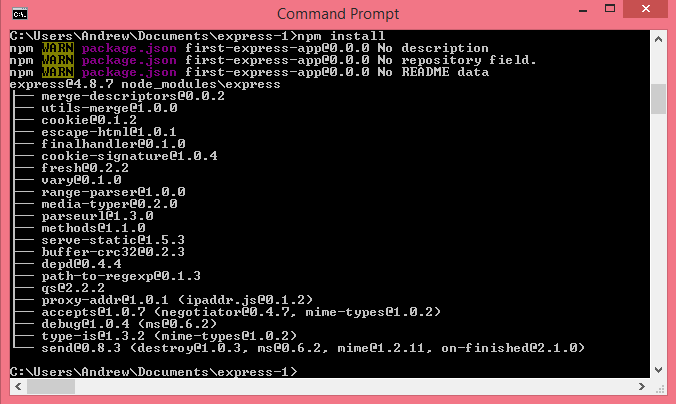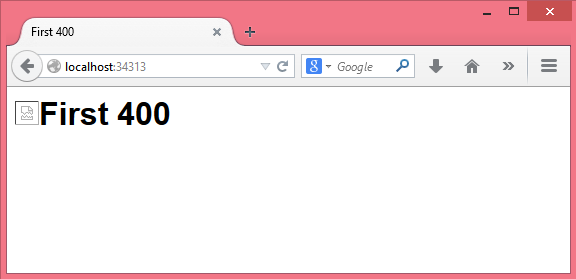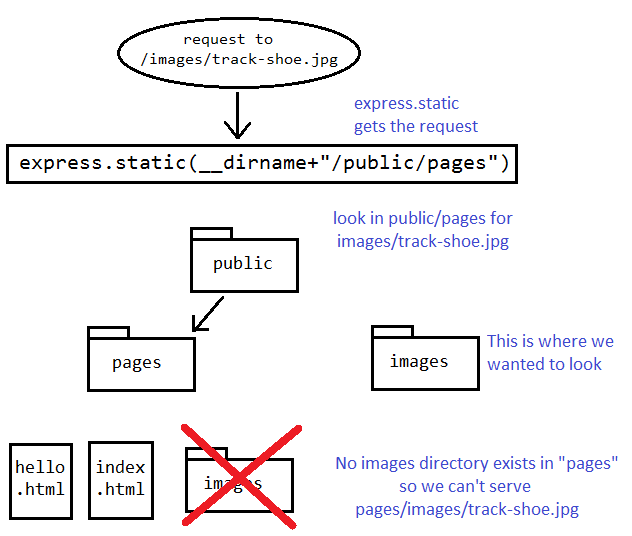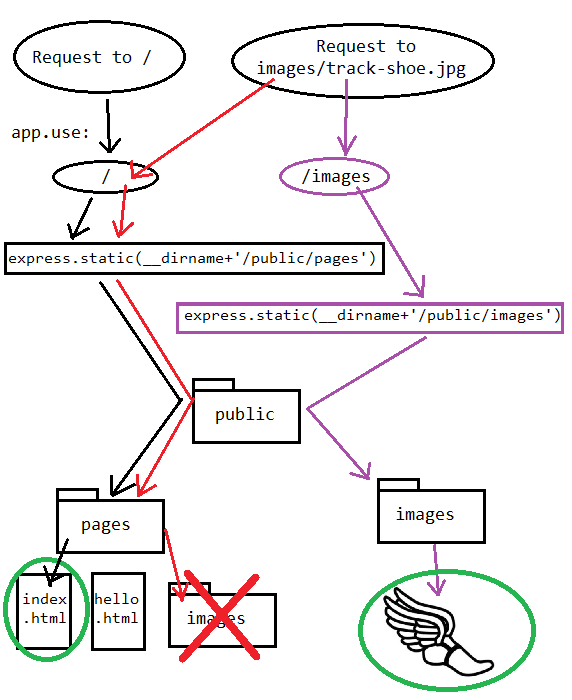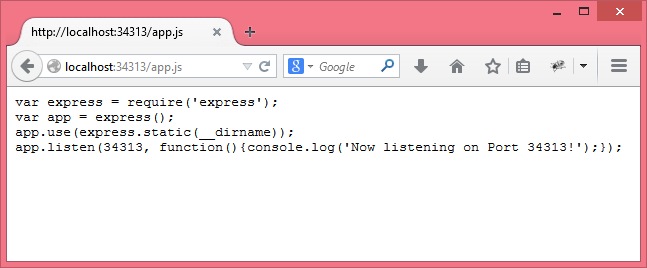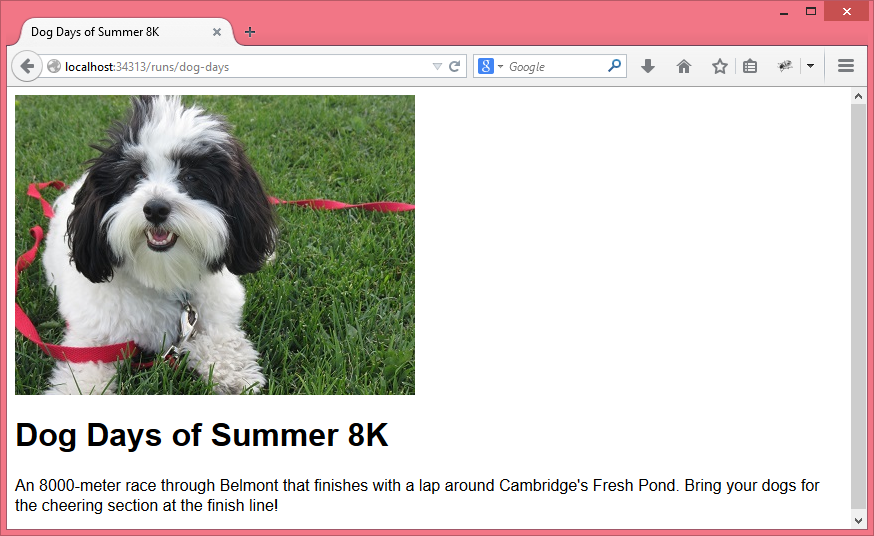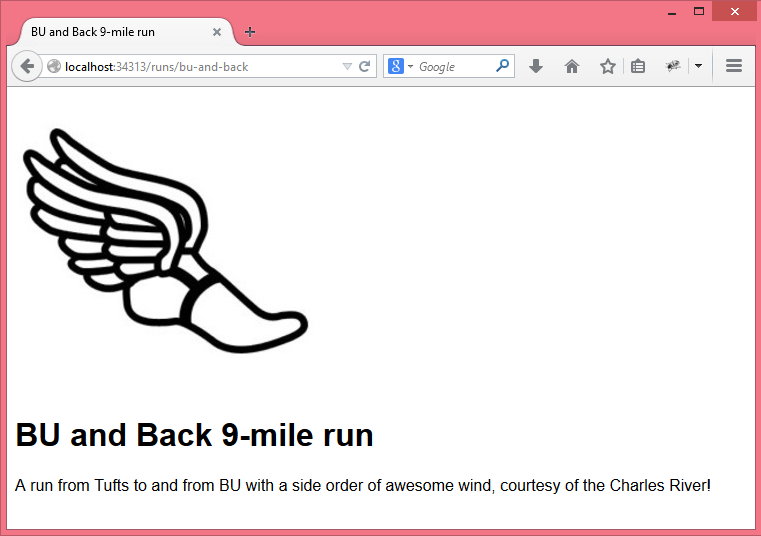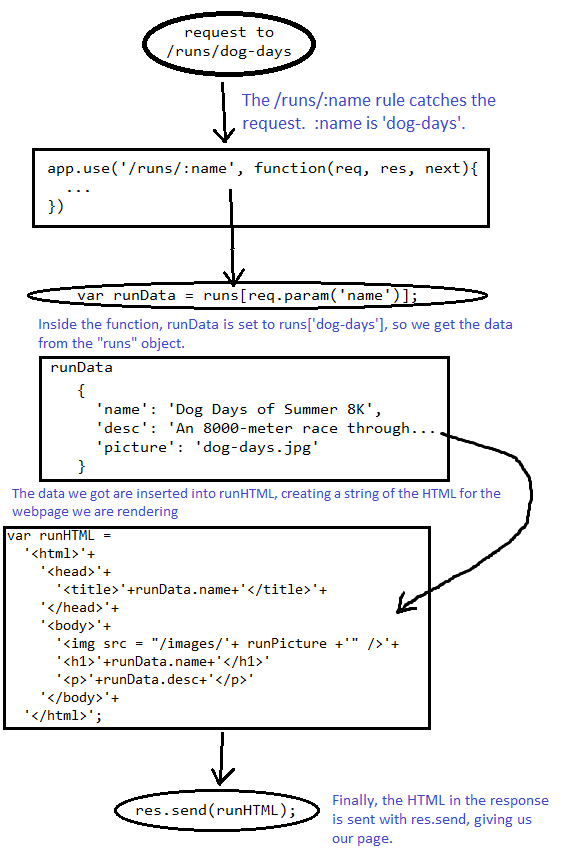Now
that you've tried making some pure-Node servers and seen the basics
of asynchronous code, time to get into the fun stuff. Most of this
tutorial will be about programming with Express, but the other really
important thing we will be seeing in this tutorial is that we are now
starting to use modules that are not part of the core of Node.js but
instead were made by other people in the programming community, and
we will be getting our new modules with an awesome tool called the
npm package manager.
Getting
Express with npm
One
really awesome thing about using the npm package manager is that it
comes bundled with Node, so if you didn't have any issues installing
Node, you shouldn't need to jump through any more "install
stuff" hoops to get it. Just type npm
in the command line to run this software and you should get a message
like this:
Now
to get Express. First make a directory called express-1
and in it create a file called package.json
and put this in the file:
{
"name":
"first-express-app",
"version":
"0.0.0",
"dependencies":
{
"express":
"4.8.7"
}
}
package.json
is a JSON file where you can describe things like the name and
version of your project, what modules it uses as dependencies, who is
contributing to the project, what license your project is under, and
a bunch more stuff. The only fields that are required in
package.json
are the name and a version.
Besides
describing your project, though, package.json
is also used for communicating with the npm package manager.
Take a look at the lines:
"express"
: "4.8.7"
}
This
specifies Express as its one dependency. The part :
"4.8.7"
specifies that we specifically want to use Express 4.8.7, which is a
fairly recent version of Express as of when I wrote this tutorial.
Note:
To get the latest version, you would put "express"
: "latest"
in your dependencies instead of "express"
: "4.8.7",
but I chose Version 4.8.7 so anyone using this tutorial is using the
same version as me.
Now
in the command line, run npm
install
and you should see this:
There
are some things to note here.
- First of all, the stuff below express@4.8.7 node_modules\express is Express's dependencies. Your project is using Express as a dependency, and Express in turn has dependencies of its own.
- Also, note that in the express-1 folder a new folder, node_modules, appeared. If you look inside this folder you will see that that's where Express is, and if you look in Express's folder, you will see that it too has a node_modules folder. Look inside there and you will see all of Express's dependencies.
Now
that Express is in your node_modules
folder, if you have
var
express = require('express');
in a JavaScript file in the express-1
directory, you will be able to use Express in your code.
From
here on out, you're no longer a solitary Node developer using only
your own code
and Node's built-in modules. Welcome to the Node community!
While
the code in this part of the tutorial only uses Express as a
dependency, your package.json file can specify a lot of packages as
dependencies. And as you can see if you look in Express's
node_modules
directory, your dependencies often have dependencies themselves.
So
what exactly is this npm package manager we're using?
The
npm package manager is the package manager for Node, and because so
many developers put Node modules they created onto the npm public
registry, you can use the code on there to add functionality to your
project without reinventing the wheel. And they have everything.
Security code, web frameworks, testing tools, you name it. If you
feel like you're re-inventing the wheel when you're writing some code
for a Node project, check npm and see if there's already a Node
module for what you want to do. Or if you have an idea for something
you want to add as a Node module, you can put write it and put it
online for other developers to use. The npm package manager can do a
lot of other useful stuff like running scripts and testing code, but
for this tutorial we will only focus on using it for getting
packages.
As
an example of a package from the npm package manager, let's go to the page for Express on
npmjs.org:
As
you can see, it shows information like its version, a description of
what it is, and who is working on the project. If you scroll further
down you will see more information, such as the module's dependencies
and what modules use Express as a dependency. Also, note its
license. Express.js uses the MIT License, which is very permissive,
and also very short.
Important
note on licenses:
Since
Node developers use a lot of modules made by other people, if you are
going to be using someone else's module, it is very important that
you know what license you are using it under. Generally I see a lot
of permissive licenses out there, but some licenses require that you
don't use the module for commercial purposes, and some require you to
give credit to whoever made the module, so make sure you know what
licenses your project's dependencies are under so you know how you
can and can't use a module in your project. Luckily, in addition to
the licenses being generally permissive, a lot of the licenses I see
are also very short, so you won't have to worry too much about
spending hours reading long licenses.
A
few other package.json fields
Before we go on, let's just add a few more fields to package.json:
{
"name":
"first-express-app",
"version":
"0.0.0",
"license":
"MIT",
"description":
"Express tutorial project",
"author":
"(insert your name here)",
"contributors":
["(One of your friends), (Another one of your friends)"],
"dependencies":
{
"express":
"4.8.7"
}
}
The
fields we added are "license",
which I put under the MIT license, "description",
which is a description of the project, and "author",
which is the name
of the author of the project. You can also add more contributors to
your project
by adding an array of contributors in the "contributors"
field; if you are
doing this tutorial with any friends, add them there.
For
a complete list of fields you can add to your package.json file,
check out
Now
let's try out Express!
As
I mentioned at the end of the first tutorial, you can make a web
server using only the core modules of Node, but it can get to be
disorganized quickly, and having to manually process the parts of the
HTTP requests and responses can lead to redundant code when you are
serving very similar files and it can get in the way of the big
picture of what your web app, as well as leaving a lot of potential
for bugs. So to get rid of some redundant HTTP
processing code, let's try serving some pages with Express!
Make
a new directory in express-1
called public
and in it:
-Create
a new directory in public
called pages
-Save
this code to pages/hello.html
<html>
<head>
<title>Home
page</title>
</head>
<body>
<h1>Hello
world!</h1>
<p>This
page was served with Express!</p>
</body>
</html>
Save
this code to pages/index.html
<html>
<head>
<title>First
400</title>
</head>
<body>
<h1><img
src="http://localhost:34313/images/track-shoe.jpg" />First
400</h1>
</body>
</html>
Then
make a new directory in public
called images
and save this picture to the images directory
as track-shoe.jpg.
Now
in the express-1
directory, make a file called app.js
and add in the code for the server:
var
express = require('express');
//1
var
app = express();
//1
app.use(express.static(__dirname+"/public/pages"));
//2
app.listen(34313,
function(){console.log("Now listening on Port 34313!");});
//3
Wow,
just four lines of code and we got a server. Go to
localhost:34313/hello.html,
we will get our Hello world page for Express:
So
how does that work?
1.
The first line requires Express as a module for Node to use, and the
second line calls the express
function to create your Express server.
2.
This line makes it so the app uses static,
which is used to serve static pages from a directory. In our case,
express.static takes in __dirname+"/public/pages",
so...
- __dirname in Node means the path for the current directory, so in our case, __dirname is "/path/to/the/directory/express-1"
- So __dirname+"/public/pages" would translate to:
- "/path/to/the/directory/express-1/public/pages"
So express.static
is being told to serve pages from that directory.
- The whole line, app.use(express.static(__dirname+"/public/pages"));, is making it so when there is a request to the server (likelocalhost:34313/some-webpage.html), express.static looks in the public/pages directory for that page, serving it if the page exists.
3.
This line starts the server in the same way you would in a regular Node app.
Express
sees we are requesting hello.html, so
express.static(__dirname+"/public/pages")
is applied, looking for hello.html
in the public/pages
directory. It finds public/pages/hello.html
and serves it.
And
if we request a page that doesn't exist, like
localhost:34313/doesnotexist.html,
Express has got us covered there:
Express
doesn't find any file named /public/pages/doesnotexist.html,
so it serves an error message
But
what if we try just localhost:34313?
The
page is served since index.html
is there but we get a broken image because we are requesting
track-shoe.jpg
with:
<img
src = "localhost:34313/images/track-shoe.jpg" />
The
request to localhost:34313/images/track-shoe.jpg is
handled by
express.static(__dirname+"/public/pages").
Express looks in public/pages
for an image with the path images/track-shoe.jpg,
but there is no directory named public/pages/images
so the request fails and we get a broken image.
Serving index.html itself looks like this:
But
the attempt to serve track-shoe.jpg looks like this:
What
we wanted was to serve the image at public/images/track-shoe.jpg,
not public/pages/images/track-shoe.jpg,
so to do that we need to add another app.use
line to our server:
var
express = require('express');
var
app = express();
app.use(express.static(__dirname+'/public/pages'));
//1
app.use('/images',
express.static(__dirname+'/public/images')); //2
app.listen(34313,
function(){console.log('Now listening on Port 34313!');});
And
then the page should be served properly:
Here's
how that works:
- The request for index.html is processed by app.use(express.static(__dirname+'/public/pages'));. public/pages/index.html is found so it's served.
- The request for images/track-shoe.jpg is made.
1.
app.use(express.static(__dirname+'/public/pages'));
tries to find public/pages/images/track-shoe.jpg,
but it doesn't exist.
2. The request is in
'/images', so
app.use('/images',express.static(__dirname+'/public/images'));
applies
to the request for the image since we are requesting something in
localhost:34313/images.
So it looks in public/images
for the picture, and the
file public/images/track-shoe.jpg
exists, so it is served.
So
serving the home page looks like:
where
the black arrows are the request to index.html
itself, the red arrows are the image request's failed attempt at
finding images/track-shoe.jpg
in public/pages,
and the purple arrows are the image request's successful attempt at
finding track-shoe.jpg
in public/images
using the second app.use
rule we added.
If
you pass in '/'
or you don't pass in any path parameter, the rule will be applied to
all
requests
to your Express server. So the rule
app.use(express.static(__dirname+'/public/pages'));
applies to all requests, so all requests to the server check for a
file in public/pages.
But
in app.use('/images',
express.static(__dirname+'/public/images'));
the path parameter is '/images'
so the rule only applies to requests to /images.
That means only requests to localhost:34313/images/[image-path-name]
are processed with a rule to serve images in public/images.
Why
not use just one app.use
rule for everything?
Now,
if we just put everything into the same directory as app.js and used
this code
(don't copy this example):
var
express = require('express');
var
app = express();
app.use(express.static(__dirname));
app.listen(34313,
function(){console.log('Now listening on Port 34313!');});
and
changed the image HTML tag in index.html
from
<img
src="http://localhost:34313/images/track-shoe.jpg" />
to
just:
<img
src="http://localhost:34313/track-shoe.jpg" />
We
would be able to serve every request from the express-1 directory
with just the one rule app.use(express.static(__dirname));,
which would take a request and just look for a matching file. So why
aren't we doing that?
Well,
if we are serving a lot of webpages, it can be really easy to get a
website with a lot of pages. Because of that, we want to keep the
directories for our project more structured. If we have a rule for
serving requests to HTML pages, a rule for serving requests to CSS
stylesheets, a rule for serving requests to front-end JavaScript
code, and a rule for serving requests for images, we can put the
folders for the pages, stylesheets, front-end JavaScript, and images
wherever we see fit. And in our case, the static HTML pages and
images are in the public
directory.
But
there is also an alarming security hole in the idea of storing all
the static HTML, CSS, JavaScript, and image files for the web app in
the same directory as the server where they can be served statically.
If you are running this server and instead of requesting an HTML
page someone requests localhost:34313/app.js...
THEY
CAN SEE YOUR SERVER-SIDE SCRIPTS!
To
prevent this, the code we were using made it so requests for static
pages and images were handled by looking in their sub-directories in
the public directory.
In
general, it's a really good practice in web development to keep
anything you're serving statically, like static HTML pages, CSS,
client-side JavaScript files, and images in a public
directory. This keeps it away from everything else, like server-side
scripts, templates, and database data.
Now
let's serve something that isn't static
As
I mentioned in the first tutorial, in this tutorial series we are
going to make a social networking site for distance runners to
organize group runs, start and find track meets, and start and join
running clubs and track teams.
This
site will be called First 400 since there are 400 meters in a track
and this site is supposed to be open to new runners looking for a
track team to join to go to meets and end up on that first lap of a
race.
So
for the first thing we will be doing for the site in this tutorial is
to make it so we can serve webpages to advertise group runs.
We
could just make an HTML page for each one, but that would mean we'd
be storing a lot of HTML pages. So instead, we are going to store
the data about each group run, including the run's name, a
description of the run, and the filename of a picture, and then we
will use that data to generate the HTML for the webpage we want to
render.
First,
save this picture to dog-days.jpg
Then,
at the top of app.js, add this:
/*Note:
This object is not how we would get data in a real project, and it
would
*not
be sustainable to put your data in your server file. On a real
project
*you
would store your data in a file, or better yet, a database.
*/
var
runs = {
'dog-days':
{
'name':
'Dog Days of Summer 8K',
'desc':
'An 8000-meter race through Belmont that finishes with a lap '+
'around
Cambridge\'s Fresh Pond. Bring your dogs for the '+
'cheering
section at the finish line!',
'picture':
'dog-days.jpg'
},
'bu-and-back':
{
'name':
'BU and Back 9-mile run',
'desc':
'A run from Tufts to and from BU with a side order of '+
'awesome
wind, courtesy of the Charles River!',
'picture':
''
}
};
And
after all the other rules in the server, add this:
app.use('/runs/:name',
function(req, res, next){ //1, 2
var
runName = req.param('name'); //3
var
runData = runs[req.param('name')];
var
runPicture = runData.picture !== '' ? runData.picture :'track-shoe.jpg';
var
runHTML =
'<html>'+
'<head>'+
'<title>'+runData.name+'</title>'+
//4
'</head>'+
'<body>'+
'<img
src = "/images/'+ runPicture +'" />'+ //4
'<h1>'+runData.name+'</h1>'+
//4
'<p>'+runData.desc+'</p>'+
//4
'</body>'+
'</html>';
res.send(runHTML);
//5
next();
});
If
you request localhost:34313/dog-days,
you should get:
And
if you request localhost:34313/bu-and-back, you should get:
So
how does this work?
1.
For this rule we are adding to the server, we are processing requests
to /runs/:name.
:name
is a URL parameter; for Express rules where you want to catch
multiple similar URL requests, you can specify parameters for your
URL,
So
in this example the one parameter is :name,
so if you request,
localhost:34313/runs/dog-days,
the :name
parameter is 'dog-days',
and in
localhost:34313/runs/bu-and-back,
the :name parameter is 'bu-and-back'.
2.
The second parameter to this call to app.use
is a function that tells the server how to handle request and
response when the user is requesting a page in /runs/:name.
3.
This function processes requests to /runs/:name,
so to get what :name
is, we
use req.param('name'),
which we then use to get the data for the run with that
name.
4.
As you can see, we are making the HTML as a string, so in different
parts of the HTML we are adding the data we got in runData
into different parts of the HTML.
5.
res.send(runHTML);
sends the HTML we made in the HTTP response, rendering our webpage.
Here
is a diagram of what happens:
So
now we route requests to /runs/:name
to serve a bunch of pages in the same format with a new app.use
rule in the server. But why is app.use
taking in a function, and what's that next parameter in the function?
You
might have guessed before, but in the previous example, with
express.static(__dirname+"/public/pages"),
what gets returned when you call the express.static
function is itself a function; express.static
is a function that returns another function. So when we are calling
app.use('/images',
express.static(__dirname+'/public/images'));
What
we are getting for the second parameter of app.use is the function
returned from
express.static(__dirname+'/public/images').
So both that app.use
rule and the app.use
rule we just created ultimately take in a path as the first argument
and then a function that processes the HTTP request and response as
the second argument.
NOTE:
The
idea of a function taking in another function or returning another
function is part of what's called functional programming. It is a
very powerful and expressive style of programming, and it is used all
over the place in JavaScript and Node. If you are new to the concept
of functional programming, confused about functional programming, or
just need to brush up on it, I recommend reading the functional
programming chapter of Eloquent JavaScript because functional
programming is everywhere.
Express
Middleware
Now,
since we are talking about those functions we give to app.use to make
what I have been referring to as "rules" for the server,
let's hear their real name: Express middleware. Express middleware
is what Express uses for processing the HTTP requests and responses.
In
Express, you can define many middleware functions that the request
and response go through before the response is finally served, so in
app.use(express.static(__dirname+'/public/pages'));
app.use('/images',
express.static(__dirname+'/public/images'));
app.use('/runs/:name',
function(req, res, next){ ... });
those
three functions are Express middleware that handle your requests.
- The first one has no path parameter so all requests go through that middleware
- Only requests to /images go through the second middleware
- Only requests to /runs/:name go through the third middleware.
Because
of that, with that request to localhost:34313/runs/dog-days,
before the function we saw earlier gave us the webpage we got, the
first middleware also attempted to process our request, but couldn't
find a file called public/pages/runs/dog-days
so that middleware failed and we moved on to the '/runs/name'
middleware.
Why
did two middleware functions try to process the app? When your
request goes through all of the Express middleware, what happens is
that the request goes through every middleware that applies to that
request. So a request to /runs/dog-days
is processed by the first and third middleware, with the server
response ultimately being sent in the third middleware.
For
another example, on the server test-middleware.js:
var
express = require('express');
var
app = express();
app.use(function(req,
res, next){req.m = 1; next()});
app.use(function(req,
res, next){req.m++; next()});
app.use('/three',
function(req, res, next){req.m++; next()});
app.use(function(req,
res, next){
req.m++;
res.send(req.m
+ " middleware were used.");
});
app.listen(34313,
function(){console.log('Now listening on Port 34313!');});
localhost:34313
would go through the first two middleware and the last one and send
the response "3 middleware were used." and
localhost:34313/three
go through all four middleware would send the response "4 middleware were used".
It
is common to have a series of middleware that can do things like
logging HTTP requests and responses in the console, giving more data
to the request, making sure a user is logged in, processing cookies,
and many other things, so several middleware functions can process a
request before a response is finally served. The way I think about
it is that middleware functions in an Express server are like an
assembly line processing a request to make the final response.
The
next() function
Also,
something else worth mentioning, what does next()
do? To find out, let's get rid of all the calls to next()
in that code and then run the code again.
Add
this to no-next.js
and run node
no-next.js:
var
express = require('express');
var
app = express();
app.use(function(req,
res, next){req.m = 1;});
app.use(function(req,
res, next){req.m++;});
app.use('/three',
function(req, res, next){req.m++;});
app.use(function(req,
res, next){
req.m++;
res.send(req.m
+ " middleware were used.");
});
app.listen(34313,
function(){console.log('Now listening on Port 34313!');});
Make
a request to localhost:34313
and you should get...
Nothing!
But why? Notice that only the very last middleware actually sends a
response, so if that last middleware isn't called, no response is
served. So what next()
does is it calls the next middleware function for our Express server.
However, next()
is not needed if an HTTP response is served within the middleware.
Where
to next?
You
might have noticed the resemblance between the way the middleware
process the request and serve the response and the way a plain Node
HTTP server handles this with the function you passed into
http.createServer.
Both of them work with HTTP requests and responses. req.param
looks like req.url
from the http
module and res.send
looks a lot like res.write.
req
and res
are still HTTP requests and responses, but with more built-in
functionality. Express also does a lot of stuff for you as far as
req
and res
go; notice that even though you still sent the HTML you didn't need
to do res.writeHead()
to write a response header, and you didn't need to do res.end().
There
are still plenty of great uses for Node's regular http
module, but for serving pages, Express abstracts away a lot of the
details of HTTP. Though it's a thin layer of abstraction, so there
isn't a lot of new material and syntax to learn before you can get
going with writing server-side scripts with Express. In fact, I
highly recommend reading through the entire API reference of Express
at http://expressjs.com/api.html. It's very short and readable, much
like Express code itself.
So
far for Express we have taken a look at how to serve static HTML with
the serve-static
middleware, we saw the npm package manager, we re-organized our static HTML and images to
their own directory, we used routing and some rudimentary templating
to render
webpages, and we've taken a closer look at what Express middleware
are.
There's
still a lot to cover in Express, but between routing and using
Express middleware, we have two fundamental building blocks for
understanding the rest of Express. The next tutorial will be Part 2
of this one, where we will be learning about templating, then
afterwards we will talk about how to use Express to handle HTTP POST
requests. And we're also going to learn how to use some other
middleware in Express.
Before
I finish this tutorial, though, I am also going to talk about a few
other websites you should know about for JavaScript and for
programming in general.
GitHub:
GitHub
is an awesome website where users can go to put their projects online
and collaboratively develop them with others. A LOT of the
programming community is using GitHub right now, from individual
developers to science labs to even huge companies like Google and
Twitter. That means there is a lot of software you can download and
use for free, and it also means that GitHub is the place to be if you
want to network as a programmer and collaborate with other
developers. And since so much of the programming community is on
there, GitHub is also a great place to stay up on what's new in
programming, which is very important to do as a developer.
Git
and GitHub take some figuring out since there are some Git vocabulary
you need to pick up to get going, but Lauren Orsini from ReadWrite
has two awesome tutorials on getting started on that at:
StackOverflow:
StackOverflow
is a very popular Q&A website on programming where if you post a
question about programming, other programmers will help you out often
in minutes and sometimes in seconds! I have found when learning new
programming languages, technologies, and concepts that if I am
confused on something, other people's StackOverflow questions often
top the Google search results, so it's easy to get a well-written
explanation on whatever I am having trouble with right on the first
page of the Google search results, making people's StackOverflow
questions a great way to supplement the tutorials I read.
That
being said, if you are asking questions on there, please make sure to
read this http://stackoverflow.com/help/how-to-ask
before posting a new question. People on there are volunteering their
time to answer programming questions for free, so it's important to
be respectful of that by following those guidelines for asking new
questions.
Twitter:
We've
all heard of Twitter, whether it's for hearing the news, telling
jokes, sharing pictures of your cat, or having yet another social
networking site for posting food pictures, Twitter is huge. And for
programmers, Twitter also is really useful for staying up on what's
going on in programming and for networking with other programmers.
If you follow Node developers on there, it's easy to get news about
what's going on in the Node.js community and you can also often find
links to tutorials for something you are trying to figure out in
programming.
For example, I've found following @AngularJS on there really useful
for finding new Angular tutorials they tweet or retweet for
navigating that framework's big ecosystem. I'm @AndyHaskell2013 by
the way.
Javascriptissexy
and Eloquent JavaScript:
As
I mentioned before, more advanced JavaScript concepts like functional
programming, callbacks, closures, and prototypal inheritance show up
all over the MEAN Stack, so knowing these are a must. Luckily, both
Javascriptissexy and Eloquent JavaScript give great explanations of
these concepts, and this year the second edition of Eloquent
JavaScript came out, so I highly recommend those tutorials.

